Learn
Stage Types
Once money has been found, the first order of business for the producer is hiring a director. As discussed in a previous lesson, the director puts together the creative team that will eventually stage a final performance for an audience. Once the actors are selected, work with the script must begin. Read the entry for "Blocking" on the Theatre Development Fund's Theatre Dictionary to learn more about this process.
But before you can begin the process of blocking (or the planning of movement on a stage), you must know what type of stage your performance would take place on.
Proscenium Stage
A proscenium stage is a stage which is like a picture frame through which the audience can see the action of the play. These are the most common types of stages. Blocking is made easy because the audience faces the stage directly and directors have the ability to plan easy entrances making an appearance on to stage and exits leaving the stage with this format.

Diagram of a proscenium stage. See larger version of the proscenium stage diagram here.
Additionally, a director can go as elaborate or as simple as he wishes with scenery, sound, and lighting. If a director chooses to be more elaborate with these items, a proscenium has plenty of space to hide speakers and lights from the audience. An area called the apron can also be used by a director as an additional playing space, even when the curtain is closed. The apron is the area of a proscenium stage that extends beyond the curtain.
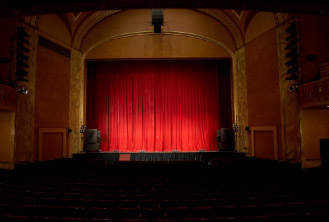
Example of a proscenium stage.
Thrust Stage
A thrust stage is a stage that is surrounded on three side by the audience. It is a rarer type of theatre.

Diagram of a thrust stage. See larger version of the thrust stage diagram here.
In this set up, a director has to always keep the audience in mind and rotate the scene from moment to moment. What happens if the director doesn't do this?
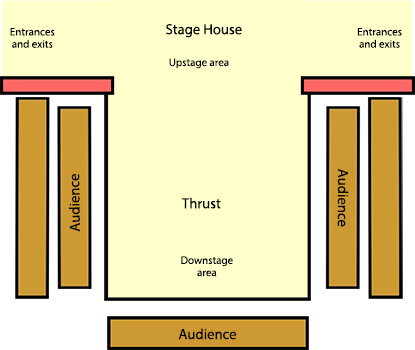
Here's another type of thrust stage. See larger version of the thrust diagram here.
The benefit of a thrust stage is that it is much more intimate and really appropriate for a small, personal show. Actors still have a backstage area and can make easy entrances and exits. However, directors have more difficulty hiding lighting or sound instruments and cannot rely on elaborate sets.
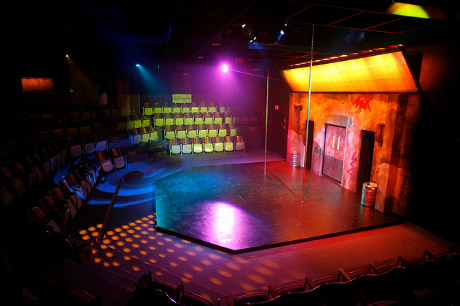
Example of a thrust stage. © UA Theatre and Dance. Image used with permission.
Arena Stage
An arena stage is a stage that is completely surrounded by audience members. It is perfect for a show with a huge audience.

Diagram of an arena stage. See larger version of the arena stage diagram here.
Working on an arena stage poses the same problems for a director. They must always keep the audience in mind and be sure that the scene is rotated from time to time. Entrances and exits are made through the audience, so there is no room for a surprise appearance of a character.
We see arena stages used in large concerts and sporting events. Although perfect for these types of events, arena stages pose the same problem as thrust stages when it comes to the placement of sound and lighting devices. The director must always keep in mind if the audience's view will be obstructed. With both arena and thrust stages, a director must focus on maintaining stage balance, which means keeping the action balanced across the stage.
ADD IMAGE HERE.
Example of an arena stage.
Flexible Stage
Flexible stages are stages that are made out of found spaces and can be arranged in any way the director needs. They are the most unusual and provide the most flexibility for a director. These are often referred to as "Black Box" stages. A flexible stage is an empty room and audience seating can be placed anywhere. A director has complete control over the playing space. This space can be rearranged as needed for any performance. Flexible stages are used any time a performance needs a performance space – think about your school cafeteria!
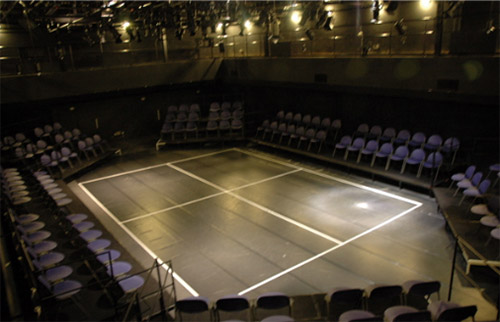
Example of a black box theatre, a type of flexible stage. Image courtesy of The Kuala Lumpur Performing Arts Center.
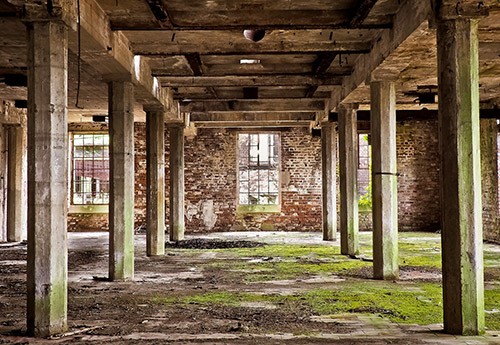
An outdoor space or a large warehouse like this one could easily be a flexible stage! | Public domain.
Stage Directions
Review the Stage Directions presentation below.
Open Stage Directions in a new window | Stage Directions text version
Note: The presentation may take a moment to load.

